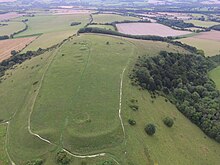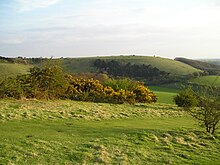 Iron Age hillfort viewed from the east | |
| Altitude | 130 m (427 ft) |
|---|---|
| Area | Hampshire |
| History | |
| Abandoned | Iron age |
| Site notes | |
| Excavation dates | Partly Excavated |
| Management | Natural England |
| Site of Special Scientific Interest | |
 | |
| Location | Hampshire |
|---|---|
| Grid reference | SU 642 208 [1] |
| Interest | Biological |
| Area | 66.2 hectares (164 acres) [1] |
| Notification | 1986 [1] |
| Location map | Magic Map |
Old Winchester Hill is a 66.2-hectare (164-acre) biological Site of Special Scientific Interest in Hampshire. [1] [2] It is a Nature Conservation Review site, Grade I, [3] and a national nature reserve. [4] Part of it is a scheduled monument. [5]

